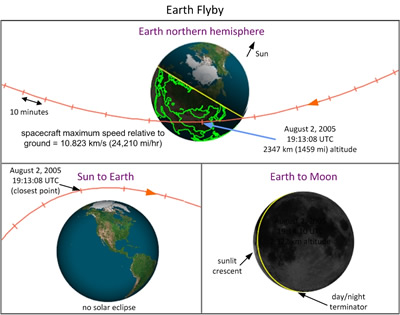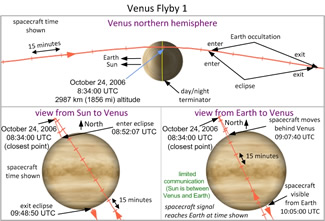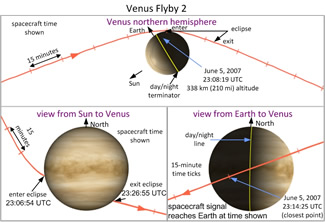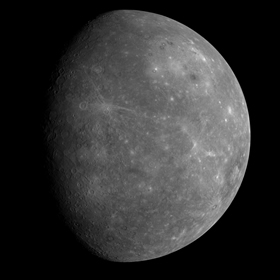Earth Flyby - August 2, 2005
Closest Approach Trajectory Highlights
See three views of the spacecraft trajectory near closest approach to the planet, as well as summary details of the spacecraft's location when closest to the planet and the gravity-assist boost imparted to the spacecraft via the flyby.
Earth flyby closest approach details:
Date and time: August 2, 2005, 19:13:08 UTC
Spacecraft distance to planet center: 8714.2 km
Altitude: 2347.5 km
Sub-spacecraft surface latitude, longitude: 47.057° N, 107.290° E
Spacecraft velocity with respect to planet center: 10.389 km/s
Effective gravity-assist velocity change from flyby: 5.996 km/s
Animations
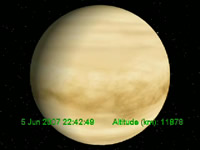
MESSENGER's View
Sm (6.0 MB) Lg (17.9 MB)
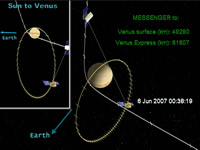
The View From Above Earth
Sm (3.8 MB) Lg (8.7 MB)
Venus Flyby 1 - October 24, 2006
Closest Approach Trajectory Highlights
See three views of the spacecraft trajectory near closest approach to the planet, as well as summary details of the spacecraft's location when closest to the planet and the gravity-assist boost imparted to the spacecraft via the flyby.
First Venus flyby closest approach details:
Date and time: October 24, 2006, 8:34:00 UTC
Spacecraft distance to planet center: 9039.1 km
Altitude: 2987.3 km
Sub-spacecraft surface latitude, longitude: 63.184° N, 213.077° E
Spacecraft velocity with respect to planet center: 12.395 km/s
Effective gravity-assist velocity change from flyby: 5.523 km/s
Animations

MESSENGER's View
Sm (4.2 MB) Lg (8.0 MB)

The View from above Venus
SM (3.9 MB) Lg (7.2 MB)
Venus Flyby 2 - June 5, 2007
Closest Approach Trajectory Highlights
See three views of the spacecraft trajectory near closest approach to the planet, as well as summary details of the spacecraft's location when closest to the planet and the gravity-assist boost imparted to the spacecraft via the flyby.
Second Venus flyby closest approach details:
Date and time: June 5, 2007, 23:08:19 UTC
Spacecraft distance to planet center: 6390.1 km
Altitude: 338.3 km
Sub-spacecraft surface latitude, longitude: 12.171° S, 164.952° E
Spacecraft velocity with respect to planet center: 13.531 km/s
Effective gravity-assist velocity change from flyby: 6.937 km/s
Animations

MESSENGER's View
Sm (4.9 MB) Lg (7.6 MB)

MESSENGER and Venus Express
Lg (21.2MB)
Mercury Flyby 1 - January 14, 2008
On January 14, 2008, more than three decades after the third Mariner 10 flyby, the last spacecraft visit of Mercury, MESSENGER passed 200 kilometers above Mercury's surface. Extensive scient ific observations were executed during this flyby encounter, including imaging a large portion of Mercury's surface that had never before been seen by a spacecraft. Listen to Principal Investigator Sean Solomon discuss the importance of this historic flyby of Mercury during a Planetary Radio show.
View images, data and movies acquired by the MESSENGER spacecraft during its flyby of Mercury. Check back often to see the latest releases!
See three views of the spacecraft trajectory near closest approach to the planet, as well as summary details of the spacecraft's location when closest to the planet and the gravity-assist boost imparted to the spacecraft via the flyby.
First Mercury flyby closest approach details:
Date and time: January 14, 2008, 19:04:39 UTC
Spacecraft distance to planet center: 2641.1 km
Altitude: 201.7 km
Sub-spacecraft surface latitude, longitude: 4.521° S, 37.730° E
Spacecraft velocity with respect to planet center: 7.097 km/s
Effective gravity-assist velocity change from flyby: 2.304 km/s
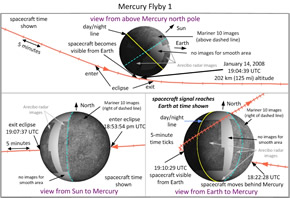
Animations

Watch an animation (10.4 MB or 84.2 MB) of MESSENGER's flyby of Mercury that shows the specific instrument operations executed during the encounter.
Mercury Flyby 2 - October 6, 2008
Overview
On October 6, 2008, the MESSENGER spacecraft passed a mere 200 kilometers (124 miles) above Mercury's surface for the mission's second flyby of its target planet. The flyby's primary purpose was to use Mercury for a gravity assist, a crucial encounter needed to enable MESSENGER, in 2011, to become the first spacecraft ever to enter into an orbit around Mercury. Though the gravity assist was the top priority for the flyby, MESSENGER's second flyby of Mercury also provided an opportunity to make significant and exciting science observations and measurements.
Images from the Flyby
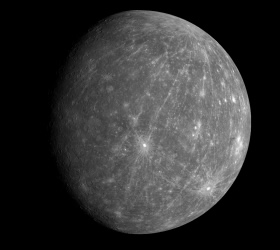
View images and movies acquired by the MESSENGER spacecraft during its flyby of Mercury. Check back often to see the latest releases as they become available!
Closest Approach Trajectory Highlights
See three views of the spacecraft trajectory near closest approach to the planet, as well as summary details of the spacecraft's location when closest to the planet and the gravity-assist boost imparted to the spacecraft via the flyby.
First Mercury flyby closest approach details:
Date and time: October 6, 2008, 8:40:22 UTC
Spacecraft distance to planet center: 2638.9 km
Altitude: 199.5 km
Sub-spacecraft surface latitude, longitude: 3.419° S, 228.945° E
Spacecraft velocity with respect to planet center: 6.616 km/s
Effective gravity-assist velocity change from flyby: 2.453 km/s
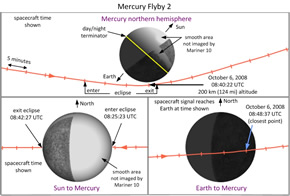
Animations

Watch an animation (17.8 MB or 98.3 MB) of MESSENGER's second flyby of Mercury that shows the instrument observations that occurred during the encounter. (Version without labels: 95 MB)
Mercury Flyby 3 - September 29, 2009
Overview
On September 29, 2009, the MESSENGER spacecraft passed by Mercury for the third time, flying 141.7 miles above the planet's rocky surface for a final gravity assist that will enable it to enter orbit about Mercury in 2011. During the encounter, the MESSENGER cameras imaged a portion of Mercury's never-before-seen surface and the Mercury Atmospheric and Surface Composition Spectrometer (MASCS) observed Mercury's exospheric "tail" during approach. With more than 90 percent of the planet's surface already imaged, MESSENGER's science team had drafted an ambitious observation campaign designed to tease out additional details from features uncovered during the first two flybys. But an unexpected signal loss prior to closest approach hampered those plans. Read this Mission News story from September 30, 2009 for more details about the flyby.
Images and Data from the Flyby
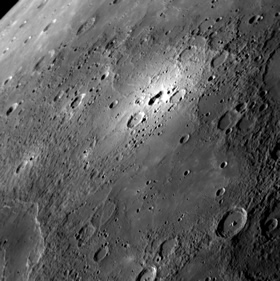
View images and movies acquired by the MESSENGER spacecraft during its flyby of Mercury. Check back often to see the latest releases as they become available!
Closest Approach Trajectory Highlights
See three views of the spacecraft trajectory near closest approach to the planet, as well as summary details of the spacecraft's location when closest to the planet and the gravity-assist boost imparted to the spacecraft via the flyby.
Third Mercury flyby closest approach details:
Date and time: September 29, 2009, 21:54:56 UTC
Spacecraft distance to planet center: 2667.2 km
Altitude: 227.8 km
Sub-spacecraft surface latitude, longitude: 0.329° S, 211.653° E
Spacecraft velocity with respect to planet center: 5.289 km/s
Effective gravity-assist velocity change from flyby: 2.836 km/s
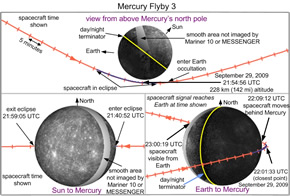
Animations

Watch an animation (94.9 MB) of the spacecraft maneuvers and the instrument observations that were planned for MESSENGER's third flyby of Mercury. (Small version without labels: 31 MB)
Mercury Orbit Insertion - March 17, 2011
Overview
On March 17, 2011 (March 18, 2011, UTC), MESSENGER became the first spacecraft ever to orbit Mercury. The first few days after orbit insertion were focused on ensuring that the spacecraft systems were working well in the harsh thermal environment of orbit; this interval is known as the orbital commissioning phase. On March 24, 2011, the instruments were turned on and checked out, and on April 4, 2011, the science phase of the mission began and the first orbital science data from Mercury were returned. The probe continued to orbit the planet once every 11.6-12 hours throughout its primary mission. March 18, 2012, marked the beginning of a 1-year extended orbital mission. On April 16, 2012, and April 20, 2012, two maneuvers were performed that resulted in a reduced orbit period of 8 hours. The spacecraft will continue to orbit Mercury once every 8 hours for the duration of the extended mission. For additional information, read Mercury Orbit Insertion and Station Keeping.
View Webcast Recording!
Download the webcast of the event (originally broadcast Thursday, March 17, 2011, 7:55 p.m. EDT)!
Windows Media Video (680 MB) | Quicktime Video (980 MB)
! NOTE: Given the large file size of the webcast, it may take extra time to download. Please be patient.
Animations

Watch this animation to view the Mercury orbit insertion maneuver and the spacecraft's first orbit around the planet.

This animation shows the expected spacecraft orientation, thruster activity, and location relative to Mercury during the Mercury orbit insertion maneuver.
